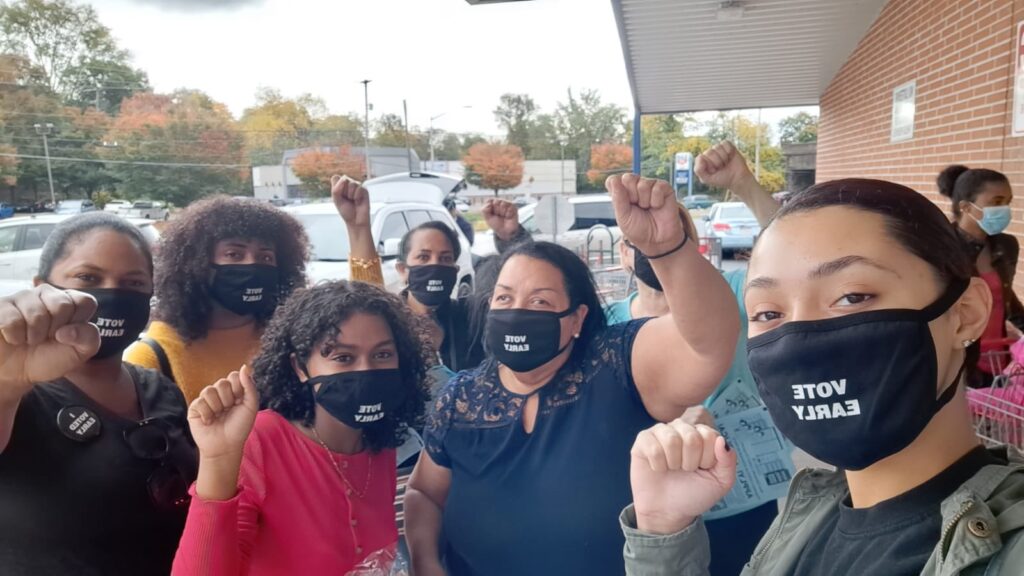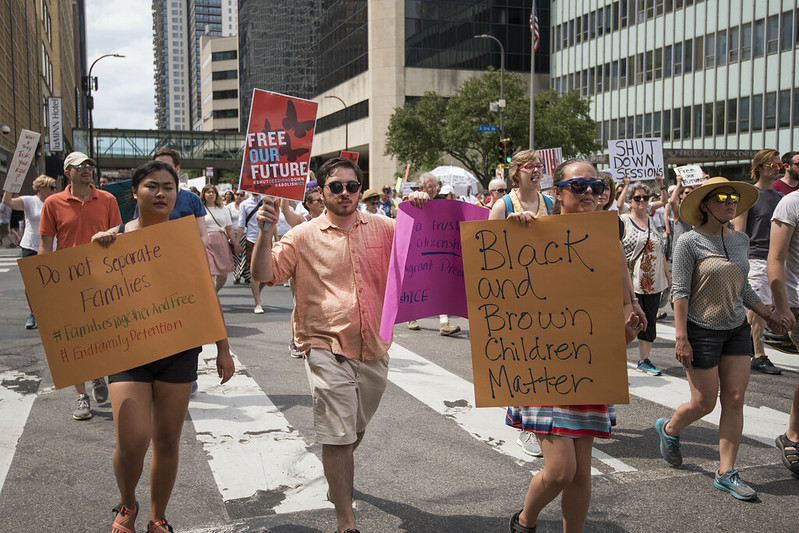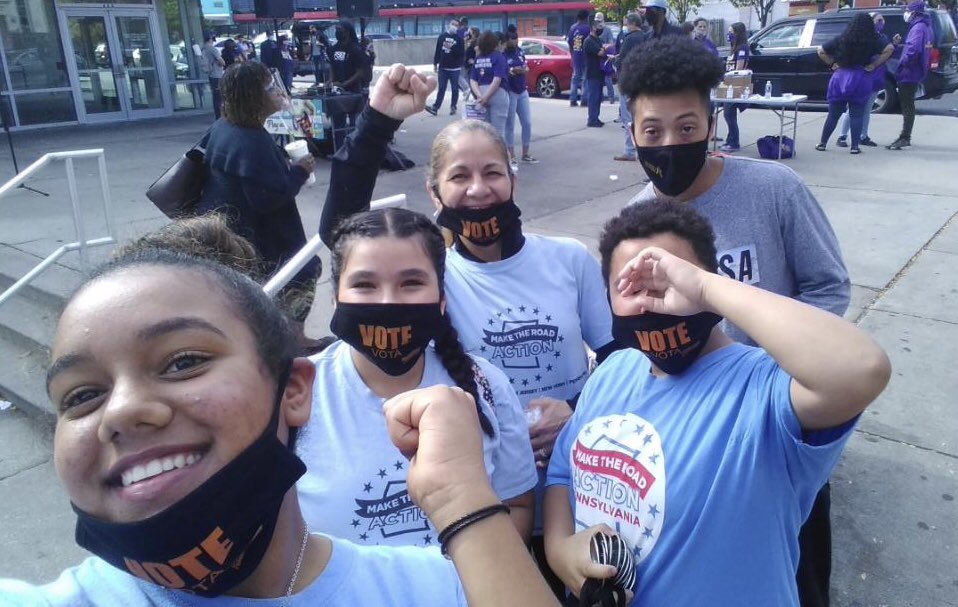The Latina electorate has the potential to flip swing states and congressional districts. This may be the year it does.

This article originally appeared on The 19th.
For organizers like Natalie Hernandez, who are doing grassroots get-out-the-vote outreach this election cycle, an unofficial slogan has emerged: “Latinas will save us all.”
For Hernandez, the deputy political director of Make the Road Action in Nevada, these words capture the spirit she’s watched bubble up in her community in recent years as Latinas have claimed their electoral power.
Roughly 32 million Latinx people are eligible to vote this year, but Democrats like Hernandez believe Latinas, specifically, could be decisive blocs in close presidential battleground states and congressional races if they turn out to vote. For years, Latinas have voted at 14 to 20 percent lower rates than other groups of women, but when they do, they skew largely Democratic—more so than men in the Latinx community—something organizations like Hernandez’s are banking on.
But Republicans are also courting Latinas heavily this election cycle. The party believes its policies on issues like supporting law enforcement and restricting abortion access are particularly resonant with them. The GOP has reached out to Latinas through programming that includes targeted in-person events, phone banking and “Latino block walks” that involve door knocking.
That’s why this year, all signs point to a mobilized Latina electorate that is already showing up—the number of Latinas who have voted in presidential elections has ticked up every year since 1984—and the coronavirus pandemic has only deepened the desire to participate.
“I truly do believe that Latinas can be the deciders this election,” said Stephanie Valencia, the president and co-founder of Equis, a Latinx research firm that has done extensive polling of Latinas. She pointed to concrete efforts aimed at reaching Latinas in battleground states like Florida, Nevada and Arizona, as well as states with substantial Latinx populations like North Carolina and Wisconsin.
In Florida, a state where the nuances of the Latinx vote play out across a region that is home to a largely Republican Cuban population, mostly Democratic Puerto Ricans and a sizable Central and South American population that also skews Democratic, Latinas could be instrumental—for both parties—in what is sure to be a close race.
In Nevada, where polls show Democratic presidential candidate Joe Biden is leading by a small margin, President Donald Trump could take the state if he secures 30 percent or more of the Latinx vote, said Leo Murrieta, the Nevada director for Make the Road Action. Right now, Trump’s in the high 20s. There, too, it could be Latinas who decide.
In some less contested presidential battlegrounds in the Midwest, for example, Democratic women like Michelle De La Isla in Kansas and Christina Hale in Indiana are running to be the first Latinas in those congressional seats, representing predominantly White districts, said Stephanie Medina, the Spanish language engagement coordinator with the Progressive Turnout Project. The shift could draw out women in the Latinx community who want to see themselves represented in congressional office.
Hernandez has watched Latinx people become more involved in politics, when the realities of the decisions made in Washington started touching their lives directly.
In 2011, immigration officials tried to detain her mother at work. Hernandez, who was 19 at the time, called her father for help only to hear as he, too, was picked up by ICE.
Two days later he was dropped off in a small town on the Mexican side of the border, still wearing his black valet uniform from the Planet Hollywood resort in Las Vegas, Hernandez said. Her family had been in the United States for more than 20 years.
The experience galvanized Hernandez, who realized most of her family members who were citizens—herself included—hadn’t voted in a U.S. election or even been informed about politics. That ended then. Since, she’s worked to help others understand what deterred so many Latinx people from voting before: that their votes count. They matter.
“I have seen that shift first hand,” she said. “I am one of those people.”

In the matriarchal Latinx community, women are the central adhesive and propulsive force. They pick up the groceries, set doctors appointments and pay bills. They make sure kids are keeping up with the school work and care for family members young and old when they’re sick. They are the moral pillars.
And they have been moving away from Trump in larger numbers than men, creating a gender gap of about 25 points—larger than the gender gap among white voters and Black voters—in a community founded on cultural norms.
Sexism, or “machismo,” is one part of the equation. Historically, Latinas haven’t been encouraged to be politically active. The refrain is calladita te ves más bonita—you’re prettier if you’re quiet.
Latinos are more likely to be breadwinners and economically conscious, a source of male pride (although many Latinas, about 19 percent, are also single heads of households). Latinos are more likely to be the providers.
“What Latino men see appealing in this administration—this idea of a strong man, this idea of a powerful man who is in command—speaks to them. Latinas have intimate knowledge about how those characteristics don’t lead to anything more than division,” said Natalia Salgado, political director at the Center for Popular Democracy Action, a progressive advocacy group. “We have a microcosm of that within our own home.”
It doesn’t necessarily come from a bad place, Salgado said, but often from men’s desire to be the “father and husband he thinks his family deserves.”
Latinas, who have the largest gender pay gap of any group, earning 54 cents on the white male dollar, face barriers to reach economic autonomy.
Lourdes Orta, a registered Republican who is voting for Biden, said she’s seen machismo play out in the Cuban American community’s support for Trump in Miami.
A friend who supports the president, she said, wears a cap that uses a Spanish colloquialism and expletive to describe Trump as well-endowed.
“What is that?” said Orta, 57. “What’s making him so macho? Because he doesn’t stand for the little guy, he bulldozes people, he bullies people?”
Orta said her dislike of Trump is so deep, a turnip could be running against him “and I would vote turnip.” Her gripes: His attitude toward women, the way he talks and her belief that he doesn’t have a strong moral compass.
But Melinda Rivera, a small business owner in Texas who voted for Trump in 2016 and voted early in person for him this year, views it differently.
“As a Latina woman, what appeals to me under this presidency is strength and protection,” she said.
That includes protection for “innocent babies in the womb” and border safety, the 48-year-old said. Rivera has helped organize “Latinos for Trump” events in New Mexico, where she travels frequently to visit her adult daughters. She has also organized to elect Republicans in that state.
“As a mom, as a grandma, it’s always been about protecting my children and protecting my young,” she said.
Trump is depending on the support of Latinas like Rivera, and the GOP recognizes their potential power. Republicans prominently featured Latinos and Latinas at the party’s summer convention, where women shared personal stories that promoted parts of the Trump administration’s record on the economy, foreign policy and immigration.
Safety is a critical issue to Latinx voters, according to Edith Jorge-Tuñón. The Cuban American is the political director for the Republican State Leadership Committee, the organization that helps Republicans win and maintain statehouse seats.
Jorge-Tuñón believes women, including Latinas, have responded to Republican messaging on security and policing. This is especially resonant in Florida, where Cuban Americans have among the highest voter turnout among Latinx eligible voter groups, and more than half of registered Cuban Americans voters say they affiliate with or lean toward the Republican Party. Driving their vote is the belief that Biden could enact policies as president that could eventually mirror social and economic conditions in communist Cuba.
Democrat Hillary Clinton received more support from Latinx voters in Florida in 2016 (66 percent). But more than half of Cuban Americans in the state (54 percent) voted for Trump, and the Republican ultimately won the state.
“When we see the left policies that are coming out of the Democratic Party, it’s scary,” said Yali Nuñez, director of Hispanic media for the Republican National Committee. “Scary for many people that flee their country because of those exact same policies.”
Some progressive Democrats support redirecting police budgets into more social services. Biden and moderate Democrats say they do not support “defunding” the police, terminology that has become polarizing.
“We are ultimately the better choice for their families, for their safety and for their future,” said Jorge-Tuñón.
But Sujyra Bundo, a Cuban who already cast her vote for Biden, thinks Trump’s policies around family separation at the border—an issue of key resonance among anti-Trump Latinas—as well as his prior disparaging remarks on women don’t make him the family candidate.
Bundo, 46, said that in Miami, where she lives, the concern over socialism under a Biden administration has overshadowed other issues, like immigration, that she feels women should be attuned to.
“What has worked with the Cuban community? Fear,” she said.
As for Trump’s policies, Bundo said his first term has set off “too many red lights. It’s not a light—it’s a sun, and to not see it you have to be blind.”
But that’s one slice of Florida voters. Non-Cuban, non-Puerto Ricans are about 40 percent of the electorate, and they’re a group that polling suggests has remained stagnant. Most support Biden, but there is room to grow that support, and Latinas may be the answer, Valencia said.
Rivera in Texas, who grew up in New Mexico close to the U.S.-Mexico border, believes that there is more nuance to the conversation over immigration. And that includes her concern about whether some children who are brought to the border are victims of human trafficking. She acknowledged a new federal report that shows the parents of hundreds of children cannot be found, but she believes it shows safety measures are working.
“If we need to ensure that those children are protected, then that’s OK,” she said. “You can twist it into child separation from their parents, or you can look at it as a precaution to make sure that children are not being trafficked.”
The campaigns have been uneven in their efforts to reach potential Latinx voters, showing a concerted push only in the final weeks on the trail when both Trump and Biden have hit Latinx strongholds in Florida and Arizona, in particular.

Nuñez, with the Republican National Committee, said the Republican party has expanded its Latinx outreach compared to the 2016 election cycle. That includes 17 new “community centers” in the battleground states of Arizona, Colorado, Florida, Nevada, New Mexico, Wisconsin, Pennsylvania and Texas.
The centers focus on Latinx voters and have hosted hundreds of related events. Nuñez said the party’s operation to reach them is completely bilingual, with paid advertisements in states like Arizona, Pennsylvania, Florida, Nevada and Wisconsin.
But for some conservatives, the issue of being labeled Latino or Latina versus American has added another layer of complexity: How do the campaigns reach certain groups if some believe labels are divisive?
“The Democrats love to have you in compartments,” said Dolores Aguirre Johnston, an Arizona Republican. “I personally find it condescending for a candidate to come to talk to me just because I am a Mexican-American.”
Still, Aguirre Johnston got involved with Latinos for Trump this year to help support the president in his reelection bid. Immigration, an issue that has turned many in the Latinx community away from Trump, is one of the reasons she supports him. In the ‘70s, Aguirre Johnston’s half brother was killed by an illegal immigrant after he demanded to be served at her father’s bar.
“When I hear people talking about the defenders of open borders, I look back and I say, ‘Well, there is a criminal element. Why did that man have a gun?’” Aguirre Johnston said. “I think the ignorance of people just shows because they act by emotion, not by basing their thoughts on the reality of what it is.”
Nuñez said the RNC is not differentiating its messaging between Latinos and Latinas.
“It makes me proud that we treat every voter the same way as far as contact goes and the policies we’re informing them about,” she said. “We do believe the voters are smart enough to realize which policies benefit them the most.”
In the Biden camp, Julie Chávez Rodríguez, a senior advisor with the campaign who heads Latinx outreach, said Democrats have worked to reach Latinx people not as a group, but by addressing the nuances of the community. They’ve held Biden events targeted at Colombians, Puerto Ricans, Mexicans, Cubans and other subgroups.
In Florida, for example, ads in Miami feature a Cuban narrator while ads in Orlando feature a Puerto Rican voice.
Other efforts have also sprung up from groups like She Se Puede, which is trying to reach Latinas where they are on social media and connecting them with the election, but also with lifestyle topics that interest them.
Questions of outreach are critical for a community of people, and particularly for Latinas, that has often felt ignored or talked down to.
If the expected growth of the Latinx vote happens this year, it could open up long-term conversations about how to effectively reach and understand Latinx voters for all their complexities—and that means understanding the different priorities between Latinos and Latinas, too.
You may also like:





